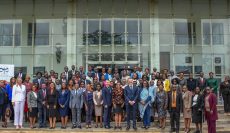
Mediation, a negotiation process in which the disputing parties are assisted by a neutral third-party, should be the first option in conflict resolution.
I recently joined a distinguished group of legal worthies and others at a breakfast hosted by Strathmore’s Dispute Resolution Centre, to talk about the benefits of mediation over litigation.
“Mediation is a sustainable way of achieving justice while preserving win-win relationships,” explained Amanda Bucklow of Facilit8, who’d just run a five-day workshop on the subject at the university.
And what a challenge this is for lawyers and judges, who have been brought up in an adversarial culture. Lawyers interrogate and cross-examine, in order to see “victory” for their client and “defeat” for their “opponent”.
As for judges, they expect to direct and decide. There is much resistance from the bar to alternative dispute resolution (ADR), and the reasons are understandable: their whole professional formation (some would call it deformation) is to assume win-lose rather than win-win resolutions; and we also heard that lawyers define ADR as an “avenue for diminishing revenue”.
The whole style of mediation, the attitudes and behaviour appropriate to facilitating others to agree among themselves, couldn’t be more different from what is needed to promote a client’s interests at the expense of those of an opponent.
Mediators need not be experts in the subject matter of the dispute. Their skills, we heard from Charles Middleton-Smith, Bucklow’s colleague at Facilit8 and a former barrister before he saw the light and turned mediator, are to do with qualities such as persistence and patience, personal rapport and humour.
I couldn’t resist nodding at this point, as this is precisely how I conduct my facilitation as a consultant, much of which relates to conflict resolution and consensus building.
Mediators provoke conversations that lead to joint decisions owned by both parties; court advocates indulge in the battle tactics of attack and defence.
“Mediation is not primarily a legal process,” we heard. “Mediators must understand the issues, but they don’t need to understand what a court would decide, which would be on the basis of the legal case only.”
In our schools we develop the adversarial skills needed for the win-lose sport of debating. But we sadly neglect nurturing the skills needed for constructive engagement.
So lawyers are able to begin training for their profession at school, and little wonder that not a few become combative politicians. It’s not surprising either that Raila Odinga shuns Parliament as a forum for “dialogue”, branding it merely a place for “debate”.
At the breakfast, Justice Alnashir Visram described how mediation works in the Ismaili community, where it has been the dominant form of conflict resolution for 1,400 years.
He himself is a trained and active mediator, and he told us about a case he once handled between a father and son.
The father had built a property business that the son grew to a substantial size. The son then claimed a share, but his father rejected the demand claiming that as the founder he was entitled to it all.
Unless the matter was settled amicably the whole business would probably have been sold off, and at a time when the property market was weak.
Enter Visram the mediator, who, after listening to both sides and asking a series of probing questions, moved away from the numbers and into the sphere of emotions.
“When your son is 25,” posed the good judge to the proud builder of his father’s business, “what do you want him to say about the legacy he inherited?” It got the man thinking, to the point where Visram led him to reflect on how to mend the relationship with his father.
It turned out that the father was not really interested in the money. All he wanted was for his son to recognise his role as founder.
And this, together with an apology, is what the old man received – with the result that an amicable settlement was reached and the business allowed to continue smoothly.
The case was resolved quickly and at low cost; the matter remained confidential between the two parties; there were no losers; and the relationship between father and son was restored.
Had it gone to court the opposite would have been the case. “Judges and lawyers don’t care about the happiness of those involved after the case is settled,” Visram admitted. “All they are interested in is the evidence.”
As I listened to the distinguished judge, I was reminded of a similar case that I mediated a few years ago between two shareholders in a company. The fight was again over the allocation of a “fair” share of equity between them.
Like Visram, I started by listening to the case presented by each side, educating myself on the history of the saga. Both parties felt hurt and misused, and each needed the other to reach out and express remorse for how they had behaved.
I encouraged a spirit of forgiveness and generosity on each side, and when I judged that both were adequately ready I brought them together. It worked, and the new deal was sealed to everyone’s satisfaction.
The momentum in Kenya is building for making mediation the approach of first resort – if only to reduce the massive case backlog that has clogged the courts.
The Judiciary’s Rules Committee (that Visram chairs) is proposing approaches that promote mediation; the Law Society of Kenya’s sub-committee on dispute resolution is working on it; and the Law Reform Commission is on the job.
Sector
As for the Kenya Bankers Association, it has partnered with Strathmore University to launch its Dispute Resolution Centre, at this stage specifically to resolve the many disputes in the banking sector.
Everyone present agreed that mediation should indeed be our first option — as is the case in Ontario, where 50 per cent of cases are resolved outside the courts. It is also how most disputes were settled in Africa before the colonialists arrived, by elders under the proverbial tree.
I left the meeting uplifted and inspired, as what I heard so fully reflects the way I look at my own life’s work of aligning human energy.





